A VERY RARE FAMILLE VERTE MODEL OF FOREIGNERS ABOARD A SHIPKangxi
Brightly glazed in red, green, aubergine and straw all over the visible areas, elaborately modelled as a junk with an aggressive fish-shaped prow, two folding Lateen masts and a flag flying from a third, a compartment with pierced windows at the stern, both sides with the muzzles of six cannons, the desk filled with four European figures wearing frock coats and wide rimmed black hats, one manning the tiller, two others standing and a fourth figure seated cross-legged. 29cm (11 1/2in) wide.Footnotes清康熙 素三彩瓷塑帆船
Provenance: an American private collection
Ralph M. Chait Galleries, New York, 10 May 2016
A European private collection
來源:美國私人收藏
Ralph M. Chait Galleries,紐約,2016年5月10日
歐洲私人收藏
Exceptionally detailed models of Chinese ships in enamels on biscuit are rare, and more so when including representations of Europeans and details such as cannons and partially folded sails as superbly detailed on the present lot.
This model of a junk is described in a 1779 inventory on Chinese porcelain in the collection of Augustus the Strong in Dresden; see a related three-glazed model of a junk, Kangxi, illustrated by E.Ströber, Maladie de Porcelaine. East Asian Porcelain in the Collection of Augustus the Strong, Berlin, 2002, p.57.
The depiction of foreigners on a boat reflects not only a growing fascination in 18th century China towards the West but the Kangxi Emperor's policy of open trade from 1684, after his consolidation of power against pirates and Ming loyalists along the coast. In dealing with the issue of overseas trade (which previous Chinese governments sometimes banned), the Kangxi Emperor supported the pursuit of profit and like many European monarchs of the day, he believed that trade — including overseas trade — benefited both state and society. On the basis of this view, in 1684, the Kangxi Emperor invited foreign merchants to bring their goods to China's ports and encouraged Chinese merchants to set out from those ports for destinations in foreign lands. More important, over the subsequent thirty years, he persisted in this open-door policy, blocking every attempt to reinstate the maritime trade ban.
This re-opening of trade with the West in the Kangxi reign led to interest in foreigners: their clothes, customs and belongings, and is reflected in a number of the arts of the period. Scrolls depicting tribute bearers from foreign lands were commissioned by the Court, in which figures from various countries were shown in their different costumes. On one such hand-scroll in the collection of the Palace Museum, Beijing, many of the figures are described as being from the West and the attributes of each couple are discussed in both Chinese and Manchu; see Splendors of a Flourishing Age, Macau, 1999, no.42.
See a similar famille verte model of a ship with Dutchmen, Kangxi, illustrated by A.du Boulay, Christie's Pictorial History of Chinese Ceramics, Oxford, 1984, p.289, no.10 (which sold at Christie's London, 13 July 1959). Foreigners can also be seen in blanc de-Chine wares; see for example P.J.Donnelly, Blanc de Chine, London, 1969, pl.117, and a blanc-de-Chine boat with foreigners, in ibid, pl.118. See also a similar famille verte boat, but without figures, Kangxi, illustrated by W.R.Sargent, The Copeland Collection: Chinese and Japanese Ceramic Figures, Salem, 1991, pp.76-77, no.29.
A VERY RARE FAMILLE VERTE MODEL OF FOREIGNERS ABOARD A SHIPKangxi
Brightly glazed in red, green, aubergine and straw all over the visible areas, elaborately modelled as a junk with an aggressive fish-shaped prow, two folding Lateen masts and a flag flying from a third, a compartment with pierced windows at the stern, both sides with the muzzles of six cannons, the desk filled with four European figures wearing frock coats and wide rimmed black hats, one manning the tiller, two others standing and a fourth figure seated cross-legged. 29cm (11 1/2in) wide.Footnotes清康熙 素三彩瓷塑帆船
Provenance: an American private collection
Ralph M. Chait Galleries, New York, 10 May 2016
A European private collection
來源:美國私人收藏
Ralph M. Chait Galleries,紐約,2016年5月10日
歐洲私人收藏
Exceptionally detailed models of Chinese ships in enamels on biscuit are rare, and more so when including representations of Europeans and details such as cannons and partially folded sails as superbly detailed on the present lot.
This model of a junk is described in a 1779 inventory on Chinese porcelain in the collection of Augustus the Strong in Dresden; see a related three-glazed model of a junk, Kangxi, illustrated by E.Ströber, Maladie de Porcelaine. East Asian Porcelain in the Collection of Augustus the Strong, Berlin, 2002, p.57.
The depiction of foreigners on a boat reflects not only a growing fascination in 18th century China towards the West but the Kangxi Emperor's policy of open trade from 1684, after his consolidation of power against pirates and Ming loyalists along the coast. In dealing with the issue of overseas trade (which previous Chinese governments sometimes banned), the Kangxi Emperor supported the pursuit of profit and like many European monarchs of the day, he believed that trade — including overseas trade — benefited both state and society. On the basis of this view, in 1684, the Kangxi Emperor invited foreign merchants to bring their goods to China's ports and encouraged Chinese merchants to set out from those ports for destinations in foreign lands. More important, over the subsequent thirty years, he persisted in this open-door policy, blocking every attempt to reinstate the maritime trade ban.
This re-opening of trade with the West in the Kangxi reign led to interest in foreigners: their clothes, customs and belongings, and is reflected in a number of the arts of the period. Scrolls depicting tribute bearers from foreign lands were commissioned by the Court, in which figures from various countries were shown in their different costumes. On one such hand-scroll in the collection of the Palace Museum, Beijing, many of the figures are described as being from the West and the attributes of each couple are discussed in both Chinese and Manchu; see Splendors of a Flourishing Age, Macau, 1999, no.42.
See a similar famille verte model of a ship with Dutchmen, Kangxi, illustrated by A.du Boulay, Christie's Pictorial History of Chinese Ceramics, Oxford, 1984, p.289, no.10 (which sold at Christie's London, 13 July 1959). Foreigners can also be seen in blanc de-Chine wares; see for example P.J.Donnelly, Blanc de Chine, London, 1969, pl.117, and a blanc-de-Chine boat with foreigners, in ibid, pl.118. See also a similar famille verte boat, but without figures, Kangxi, illustrated by W.R.Sargent, The Copeland Collection: Chinese and Japanese Ceramic Figures, Salem, 1991, pp.76-77, no.29.
.jpg)

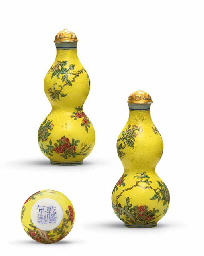
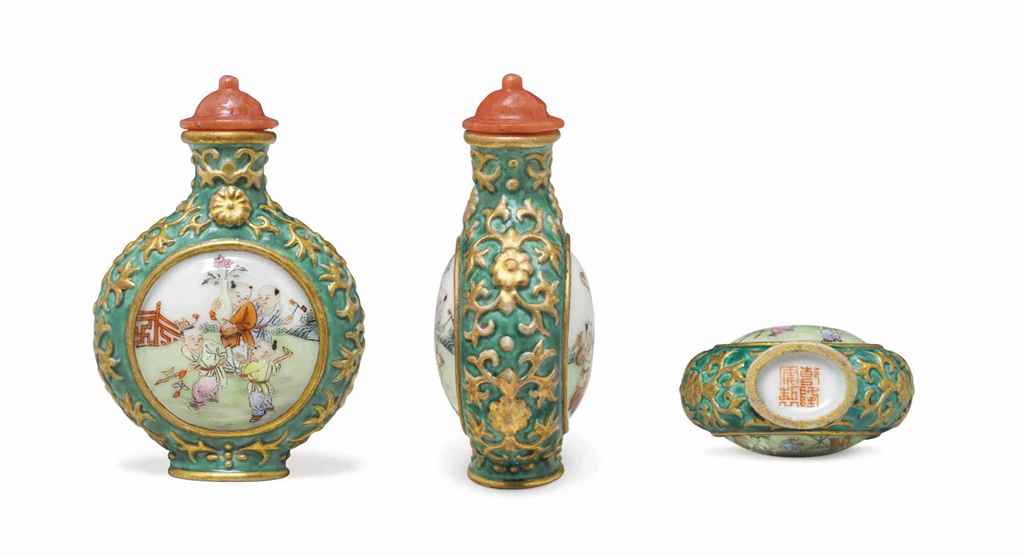


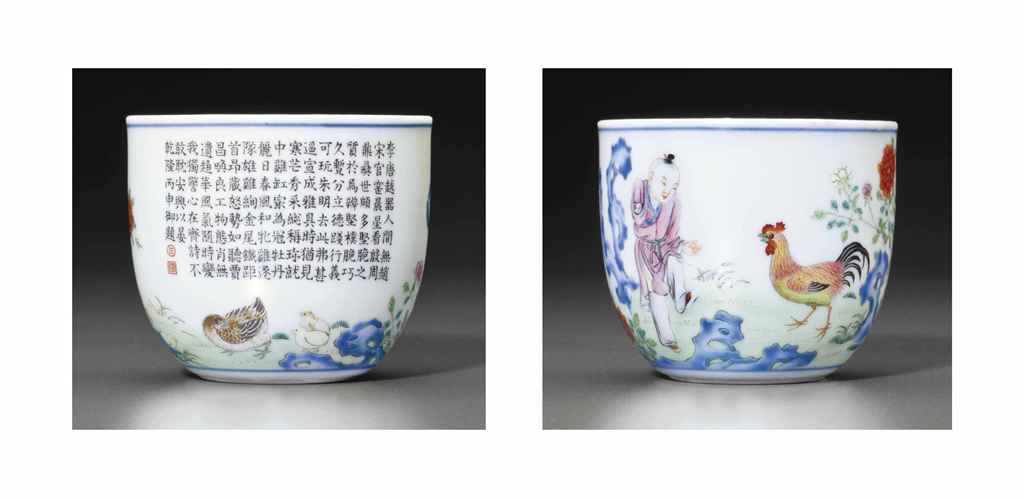
.jpg)
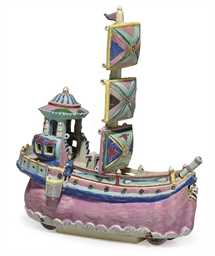
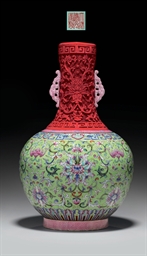





Testen Sie LotSearch und seine Premium-Features 7 Tage - ohne Kosten!
Lassen Sie sich automatisch über neue Objekte in kommenden Auktionen benachrichtigen.
Suchauftrag anlegen